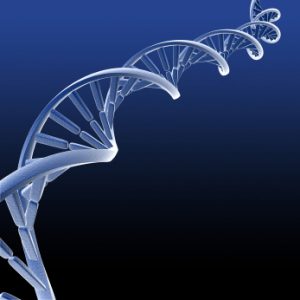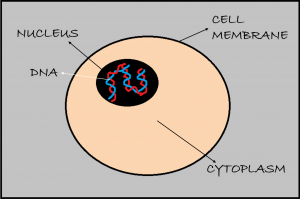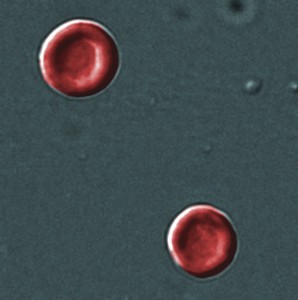Does every cell in our body contain DNA?
Callum Campbell
DNA is one of the coolest discoveries in all of cell science. Most people have heard of it, but might not really know what it actually is or why it’s important. To answer the question of whether every cell has DNA or not, we have to dig into some of this DNA detail first!
What does DNA do?
DNA is a long  twisty molecule which looks a bit like a ladder, but what does it actually do?
twisty molecule which looks a bit like a ladder, but what does it actually do?
Imagine a busy, bustling restaurant. Waiters running everywhere, chefs cooking 5 dishes at once, customers eating and chatting, cleaners cleaning – pure chaos! This is what a cell in your body is like; 100 different things going on all at once on the inside, but somehow it’s all pulled off flawlessly. What’s the secret to it? It turns out, hidden away somewhere in our restaurant, we have a secret safe which contains a top secret file. This file is the restaurant’s Master Plan – it contains recipes for the food, instructions for the staff, lists of where to get tables and chairs and utensils, which food to buy, even how to use the heating – it has every single thing we need in it. This is our DNA; our cell’s Master Plan. DNA tells us how to build every single thing inside every single cell and keep it running smoothly day and night. It’s the most enormously long and complex list of instructions ever made! Without it, all our cells would stop working and quickly fall apart just like a restaurant with no recipes.
As you can see, our DNA is pretty important, so to  keep it safe it’s stored inside a bubble in our cells called the nucleus. You can see the nucleus of a cell under a microscope – it’s the dark blob in the middle!
keep it safe it’s stored inside a bubble in our cells called the nucleus. You can see the nucleus of a cell under a microscope – it’s the dark blob in the middle!
Do all cells have DNA?
Almost all of them do, yes! Most cells do such complicated work that DNA is essential for them to function. A liver cell for example has many, many functions; it cleans your blood of toxins, makes important proteins and stores sugar to name just a few of them. In order to do all these things it needs the DNA instructions.
It might surprise you to know, however, that some cells can manage without any DNA at all! These are the exceptions to the rule: red blood cells and platelets.
Red blood cells and platelets a re very simple cells. The former carries oxygen around the body, and the latter helps our blood clot and form a scab to heal an injury. Now, these are essential functions to our survival for sure, but they don’t actually require very many instructions. In reality, it wouldn’t be much of a simplification to say that red blood cells are just big bags of haemoglobin (oxygen carrying molecules), and platelets are just bags of clotting factors! This rare cell simplicity is why they don’t require any DNA.
re very simple cells. The former carries oxygen around the body, and the latter helps our blood clot and form a scab to heal an injury. Now, these are essential functions to our survival for sure, but they don’t actually require very many instructions. In reality, it wouldn’t be much of a simplification to say that red blood cells are just big bags of haemoglobin (oxygen carrying molecules), and platelets are just bags of clotting factors! This rare cell simplicity is why they don’t require any DNA.
There are some downsides to having no DNA though. Red blood cells and platelets don’t have the instructions to undergo mitosis, which means that they can’t divide to make more. This is why red blood cells and platelets are actually manufactured by other cells in our bone marrow which do have DNA!
It’s also worth noting that our outermost skin cells, nail cells and hair cells don’t have DNA either – but that’s because they have no processes going on inside them at all – they’re dead cells which act as a barrier and insulator to protect our body from harm.
Oh, one last thing…
Ever wondered what DNA stands for? Deoxyribonucleic acid. Try saying that in a hurry!
